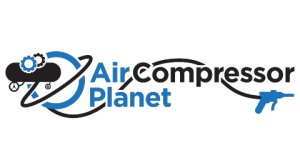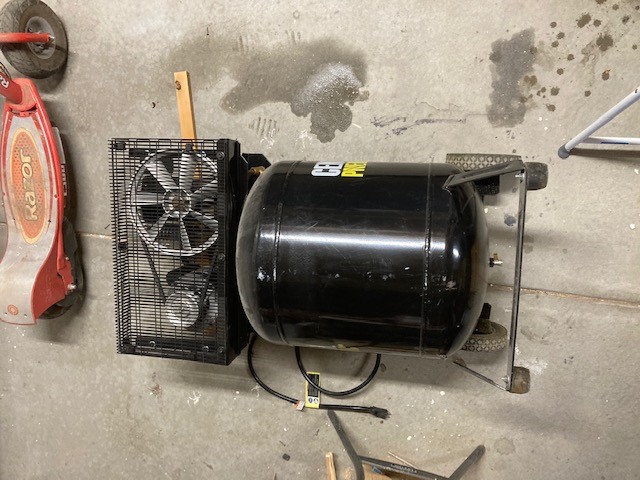If you are buying a new air compressor or a second-hand air compressor, and you arrive with your vehicle to load it in, one question may come to light: what’s the best way to transport and store it, without damaging the unit?.
Can you lay or store an air compressor on its side? If an air compressor is brand new and you are transporting it from the store to your workshop, you will be able to transport it on its side, because a new air compressor is not usually filled with oil. On the other hand, if you are purchasing a second-hand air compressor, do not lay it on its side. The oil in the tank will foul up certain parts, and the compressor will not work. This also applies when storing an old air-compressor.
In this article, you will learn how to transport and store your air compressor. You will also learn the difference between oil-lubricated air compressors and oil-free air compressors, and how the units compare. We’ll discuss how air compressors work, and how to maintain and service them to keep them working for you!
What Could Happen if You Leave your Air Compressor on its Side?
Over time, an old air compressor builds up old oil at the bottom of the compressor tank. This old oil has bypassed the intake filter and has entered the compressor tank with the compressed air. When placed on its side, this old oil can get into the check value, which is located where the airline for the pump enters, and the old oil will cause the compressor not to work.

Should the air compressor be stored on its side for a long time, the oil will dry in the check valve, and this will prevent the check value from working. Therefore, the air compressor will not work.
However, if you have an oil-free air compressor, this won’t be much of an issue. Find out which kind you are purchasing before you lay it on its side. If you haven’t purchased a compressor yet, maybe you aren’t sure which kind to get. Let’s talk about both types
Difference Between an Oil-Lubricated Air Compressor and an Oil-Free.
| Types of Air Compressors | Oil-Lubricated Air Compressor | Oil-Free Air Compressor |
| Differences between the two types of compressors | Oil-lubricated air compressors are more expensive. They are heavier in weight. They are more durable. They run cooler. They require more maintenance. They are not very loud when running. Used for commercial use. They need lubrication to run. They cause air pollution. | Oil-free air compressors are less expensive. There are lighter in weight. They are less durable. They run hotter. They require less maintenance. They are very loud when running. Used for home use. They are pre-lubricated with Teflon. They are environmentally friendly. |
How an Air Compressor Works
Knowing how your machine works is important for learning how to properly care for it and use it. Becoming familiar with what parts are in it and how they function can also help you be attuned to your air compressor and know when something isn’t quite right.
The electric pump forces air to the tank: Air Compressors have an electric motor, which is connected to a pump. This electric pump takes air and forces it under pressure into the tank.
A gauge on the tank: There is a gauge at the side of the take, which gives a reading as to how much pressure is in the tank. This gauge measures, pounds per square inch. For example, your tank can read 100 psi.
The second gauge reading: A second gauge is found where the air comes out of the tank. This gauge shows us what pressure is coming out of the tank and goes through a tube to the tool one is using. This gauge can be regulated by turning the regular button, which is usually found above the gauge. The regular button can be turned up and down depending on what pressure the tool needs.
Tool psi rating: Every tool has a different psi rating, depending on how much-forced air is needed to power the tool.
The size of the air compressor: The size of the air compressor is important for its application. They are made in gallons. For example, you can purchase a small 1-gallon air compressor for portable use. You can also purchase dual tanks, which can go up to 200-gallon tanks for industrial use.
What is the SCFM: One must also consider the SCFM (Standard cubic feet per minute). This is the volume of the air compressor. Different volumes can put out different psi ratings. If, for example, you are using an air compressor for a spray painting job, you need more volume because you are constantly spraying.
Compare this to a job that requires you to use a nail-gun – you may be shooting nails pretty consistently, but your compressor isn’t working constantly.

How to Maintain your Air Compressor:
- Drain moisture from the tanks: The air compressor’s receiver tank will collect moisture from the air. The collection tank can also accumulate moisture, especially if the humidity is high. It is a good idea to check that the tank has drained after use. Before it can be drained, you must make sure to release the pressure from the air tank.
- Clean intake vents: By cleaning your intake vents regularly, you will be ensuring that your air compressor will not work under large loads. Keeping vents clean helps to increase the life-span of the air compressor.
- Clean air filters: Any air-related machine requires clean vents, as well as clean air filters, to operate at maximum efficiency. This also ensures that your air compressor will not overheat and have a longer life-span. Use compressed air and blow them out every six months, or sooner if you are doing a particularly dirty job that is spreading dust, dirt or sawdust into the air.
- Other maintenance: Clean heat exchanges, check that all fasteners are tight, change the compressor oil, and change the separator element occasionally. Every minute and dollar you spend on maintenance goes a long way toward extending the life of your compressor.


